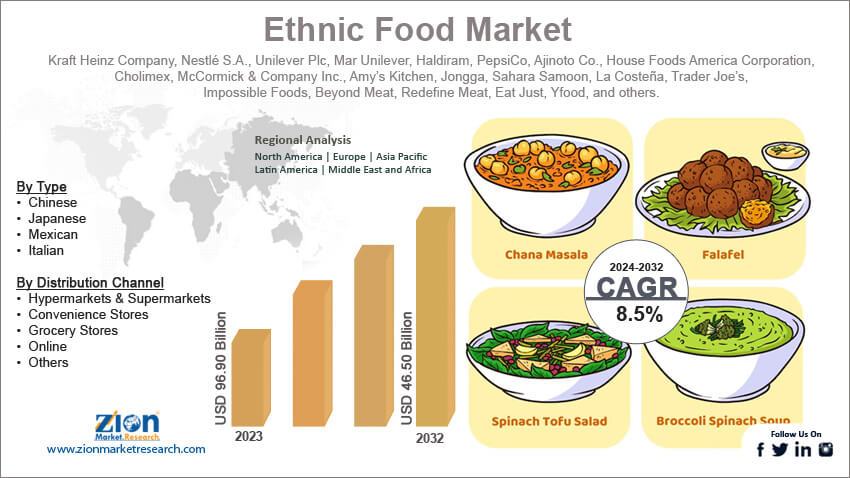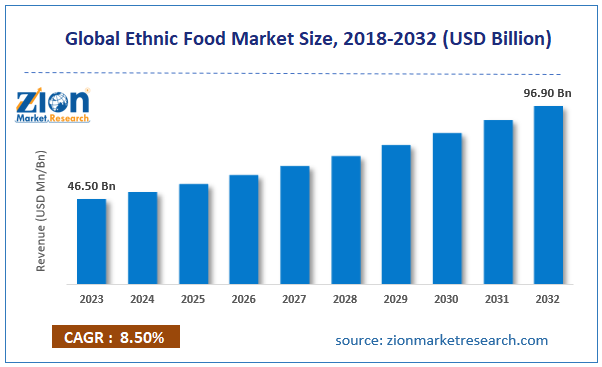Ethnic Food Market Size, Share Report, Analysis, Trends, Growth 2032

Ethnic Food Market By Type (Chinese, Japanese, Mexican, Italian, and Others), By Distribution Channel (Hypermarkets & Supermarkets, Convenience Stores, Grocery Stores, Online, and Others), and By Region - Global and Regional Industry Overview, Market Intelligence, Comprehensive Analysis, Historical Data, and Forecasts 2024 - 2032
| Market Size in 2023 | Market Forecast in 2032 | CAGR (in %) | Base Year |
|---|---|---|---|
| USD 96.90 Billion | USD 46.50 Billion | 8.5% | 2023 |
Ethnic Food Industry Perspective:
The global ethnic food market size was worth around USD 46.50 billion in 2023 and is predicted to grow to around USD 96.90 billion by 2032 with a compound annual growth rate (CAGR) of roughly 8.5% between 2024 and 2032.
Ethnic Food Market: Overview
Distinct flavors, cooking methods, and ingredients unique to a given ethnic group or geographic area are often used to define ethnic meals, which are culinary dishes and ingredients developed from distinctive cultural or regional traditions. These dishes, which include Mexican, Italian, Indian, Chinese, and other cuisines, reflect the cultural legacies and eating customs of numerous communities worldwide. Ethnic foods also have many other uses, such as promoting culinary tourism and cross-cultural exchange while also catering to a variety of customer palates in restaurants, food festivals, and home cooking.
Key Insights
- As per the analysis shared by our research analyst, the global ethnic food market is estimated to grow annually at a CAGR of around 8.5% over the forecast period (2024-2032).
- In terms of revenue, the global ethnic food market size was valued at around USD 46.50 billion in 2023 and is projected to reach USD 96.90 billion by 2032.
- The growing urbanization and population are expected to drive the ethnic food market growth over the forecast period.
- Based on the type, the Chinese segment is expected to dominate the market during the forecast period.
- Based on the distribution channel, the hypermarkets & supermarkets segment is expected to hold a prominent market share over the projected period.
- Based on region, Europe is expected to dominate the market during the forecast period.
 Request Free Sample
Request Free Sample
Ethnic Food Market: Growth Drivers
Growing urbanization and population drives market growth
Global population movements into urban regions have an impact on the consumption of ethnic foods. Many people living together in urban areas create a melting pot of culinary traditions, which raises the demand for a greater range of foods. The U.S. Census Bureau reports that the country's multiracial population grew dramatically from 9 million in 2010 to 33.8 million by 2020—a startling 276% increase. This increase reflects the growing variety of the nation and how it affects food preferences. There was a 24 million growth in the Asian population, a 9.7 million increase in American Indian and Alaska Native people, and a 1.6 million increase in Native Hawaiian and other Pacific Islander people. Additionally, because of the population's diversity and the concentration of eateries that cater to a variety of clientele, metropolitan settings typically offer greater exposure to ethnic experiences. Therefore, this urban change makes ethnic cuisines more readily available, and it also encourages the industry's continued growth because of the industry's enduring client demand, which is driven by demographic diversification. This creates a favorable outlook for the ethnic food market.
Ethnic Food Market: Restraints
Consumer inclination towards natural products hinders market growth
The advantages of consuming natural foods are coming to the attention of consumers. Since food products from different ethnic groups are frequently transported between nations, some edible chemical preservatives must be used. However, ethnic groups may have challenges when attempting to preserve their products for an extended length of time as the usage of natural components in food products grows more widespread. In addition, as the sea is the main mode of transportation used worldwide, it takes time for the commodities to reach their destination. Using natural substances to extend the shelf life of the items would not always be possible in these situations. To overcome these challenges, local manufacturers must work with a few foreign businesses. With so many small and local enterprises, it could be difficult to make the transition from chemical to natural substances, which could impede the global ethnic food industry's expansion.
Ethnic Food Market: Opportunities
Increasing product launches offers a lucrative opportunity for market growth
Increasing product launches is expected to offer a lucrative opportunity for ethnic food market growth during the forecast period. For instance, in February 2023, The largest food corporation in the world, Nestlé, announced that from March 7–11 in Anaheim, California, it will present and sample new products at the Natural Products Expo West 2023 Trade Show. In addition to separate booths for Nestlé Health Science brands Solgar® (#3739), Vital Proteins® (#3215), Garden of Life® (#4031), Orgain® (#2037) and Nuun® (#715), and pet food brand Castor & Pollux® (#1017), the company will showcase 35+ products across 15+ brands in one Nestlé USA booth (#527). This is done to highlight innovation across the plant-based and nutrition, health, and wellness categories, which continue to be a key component of the company's business strategy.
Ethnic Food Market: Challenges
Appropriation of culture, food safety, and cleanliness poses a major challenge to market expansion
The biggest problem with ethnic cuisine is the potential for cultural appropriation. The act of introducing elements of a minority culture into the dominant society without due recognition, respect, or understanding is referred to as cultural appropriation. This may result in customs, ingredients, or cooking methods being changed or distorted, which would be detrimental and disrespectful to the original culture. Ethnic cuisine includes a variety of unusual ingredients, nontraditional cooking methods, and traditional cooking methods which require training, experience, and strict adherence to sanitary and food safety laws. Improper handling, storing, or cooking of different ethnic foods can lead to food-related illnesses. To reduce these risks, it is essential to ensure proper training and education in food safety.
Ethnic Food Market: Segmentation
The global ethnic food industry is segmented based on type, distribution channel, and region.
Based on the type, the global ethnic food market is bifurcated into Chinese, Japanese, Mexican, Italian, and others. The Chinese segment is expected to dominate the market during the forecast period. This is mostly attributable to the rising popularity of Chinese food around the world. The market is expanding because of the growing demand for Chinese food from developed regions like Europe. Chinese students are moving to North America and Europe at a rapid pace, and this trend is still going strong. In 2020, around 35% of non-European students in Europe were of Chinese ethnicity, according to the Higher Education Statistics Agency. This percentile has climbed by 56% from 2016. This is helping to explain why Chinese food is in more demand in North America and Europe. Thus, driving the revenue growth.
Based on the distribution channel, the global ethnic food industry is bifurcated into hypermarkets & supermarkets, convenience stores, grocery stores, online, and others. The hypermarkets & supermarkets segment is expected to hold a prominent market share over the projected period. The largest market share is predicted to be accounted for by developments in the organized retail sector and the increasing number of supermarkets and hypermarkets worldwide. The main factor influencing this segment's growth is the expansion of metro areas and migration to these areas. Additionally, elevated consumer behavior determines preferences based on the legitimacy and safety of the goods purchased from supermarkets and hypermarkets. Additionally, the growing variety of Asian ethnic foods available in supermarkets is driving the rise of this sector.
Ethnic Food Market: Report Scope
| Report Attributes | Report Details |
|---|---|
| Report Name | Ethnic Food Market |
| Market Size in 2023 | USD 46.50 Billion |
| Market Forecast in 2032 | USD 96.90 Billion |
| Growth Rate | CAGR of 8.50% |
| Number of Pages | 218 |
| Key Companies Covered | Kraft Heinz Company, Nestlé S.A., Unilever Plc, Mar Unilever, Haldiram, PepsiCo, Ajinoto Co., House Foods America Corporation, Cholimex, McCormick & Company Inc., Amy’s Kitchen, Jongga, Sahara Samoon, La Costeña, Trader Joe’s, Impossible Foods, Beyond Meat, Redefine Meat, Eat Just, Yfood, and others. |
| Segments Covered | By Type, By Distribution Channel, and By Region |
| Regions Covered | North America, Europe, Asia Pacific (APAC), Latin America, Middle East, and Africa (MEA) |
| Base Year | 2023 |
| Historical Year | 2018 to 2022 |
| Forecast Year | 2024 - 2032 |
| Customization Scope | Avail customized purchase options to meet your exact research needs. Request For Customization |
Ethnic Food Market: Regional Analysis
Europe is expected to dominate the market during the forecast period
Europe is expected to dominate the global ethnic food market during the forecast period. This is primarily due to the increased immigrant population in European nations like the United Kingdom, Germany, France, etc. Because of better education, jobs, and tourism, the number is probably going to keep rising over the projection period. The region's established and well-organized retail sector and rising utilization of internet channels are further factors contributing to its higher market share. Easy availability and access encourage greater customer adoption. The market for ethnic cuisine is expanding as a result of increased health consciousness in the area and rising intake of nutrient-dense ethnic food. The significant regional share in the global market is also attributed to stronger consumer spending power and per capita income.
Ethnic Food Market: Competitive Analysis
The global ethnic food market is dominated by players like:
- Kraft Heinz Company
- Nestlé S.A.
- Unilever Plc
- Mar Unilever
- Haldiram
- PepsiCo
- Ajinoto Co.
- House Foods America Corporation
- Cholimex
- McCormick & Company Inc.
- Amy’s Kitchen
- Jongga
- Sahara Samoon
- La Costeña
- Trader Joe’s
- Impossible Foods
- Beyond Meat
- Redefine Meat
- Eat Just
- Yfood
The global ethnic food market is segmented as follows:
By Type
- Chinese
- Japanese
- Mexican
- Italian
- Others
By Distribution Channel
- Hypermarkets & Supermarkets
- Convenience Stores
- Grocery Stores
- Online
- Others
By Region
- North America
- The U.S.
- Canada
- Europe
- France
- The UK
- Spain
- Germany
- Italy
- Rest of Europe
- Asia Pacific
- China
- Japan
- India
- South Korea
- Southeast Asia
- Rest of Asia Pacific
- Latin America
- Brazil
- Mexico
- Rest of Latin America
- Middle East & Africa
- GCC
- South Africa
- Rest of Middle East & Africa
Table Of Content
Methodology
FrequentlyAsked Questions
Distinct flavors, cooking methods, and ingredients unique to a given ethnic group or geographic area are often used to define ethnic meals, which are culinary dishes and ingredients developed from distinctive cultural or regional traditions. These dishes, which include Mexican, Italian, Indian, Chinese, and other cuisines, reflect the cultural legacies and eating customs of numerous communities worldwide.
The ethnic food market is being driven by several factors including the growing urbanization and population, rising product launches, increasing collaboration, the increasing popularity of convenience products, and many others.
According to the report, the global ethnic food market size was worth around USD 46.50 billion in 2023 and is predicted to grow to around USD 96.90 billion by 2032.
The global ethnic food market is expected to grow at a CAGR of 8.5% during the forecast period.
The global ethnic food market growth is expected to be driven by Europe. It is currently the world’s highest revenue-generating market due to the presence of major players.
The global ethnic food market is dominated by players like Kraft Heinz Company, Nestlé S.A., Unilever Plc, Mar Unilever, Haldiram, PepsiCo, Ajinoto Co., House Foods America Corporation, Cholimex, McCormick & Company Inc., Amy’s Kitchen, Jongga, Sahara Samoon, La Costeña, Trader Joe’s, Impossible Foods, Beyond Meat, Redefine Meat, Eat Just and Yfood among others.
The ethnic food market report covers the geographical market along with a comprehensive competitive landscape analysis. It also includes cash flow analysis, profit ratio analysis, market basket analysis, market attractiveness analysis, sentiment analysis, PESTLE analysis, trend analysis, SWOT analysis, trade area analysis, demand & supply analysis, Porter’s five forces analysis, and value chain analysis.
HappyClients
Zion Market Research
Tel: +1 (302) 444-0166
USA/Canada Toll Free No.+1 (855) 465-4651
3rd Floor,
Mrunal Paradise, Opp Maharaja Hotel,
Pimple Gurav, Pune 411061,
Maharashtra, India
Phone No +91 7768 006 007, +91 7768 006 008
US OFFICE NO +1 (302) 444-0166
US/CAN TOLL FREE +1 (855) 465-4651
Email: sales@zionmarketresearch.com
We have secured system to process your transaction.
Our support available to help you 24 hours a day, five days a week.
Monday - Friday: 9AM - 6PM
Saturday - Sunday: Closed





